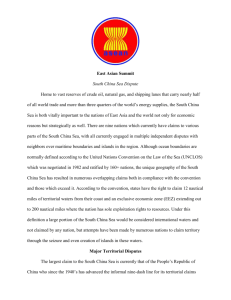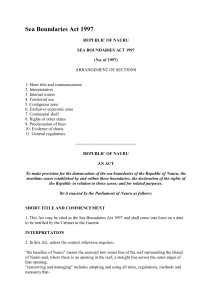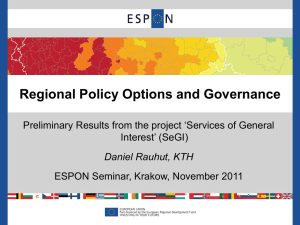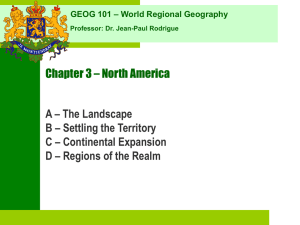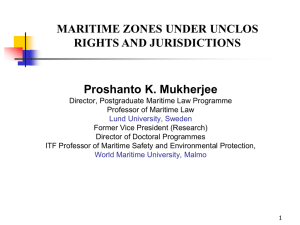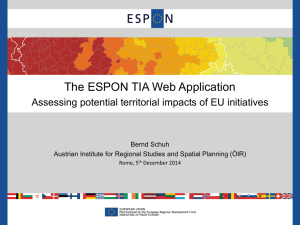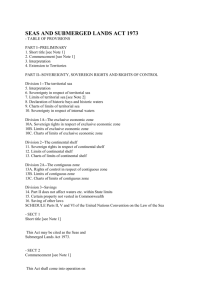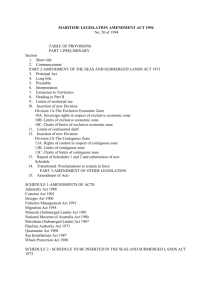Law of the Sea
advertisement
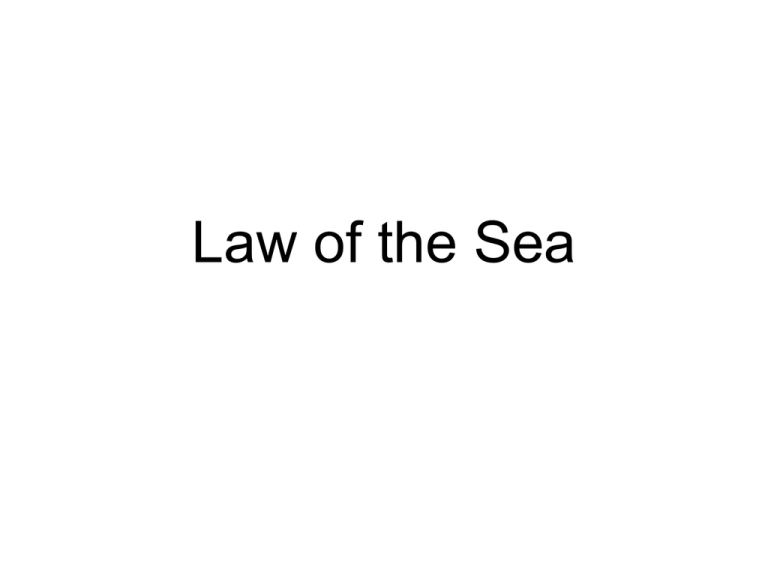
Law of the Sea • Resources • Transport - Mineral Resources - Navigation - Oil - Cables - Gas - Pipelines - Fish - Renewable Energies • Environment - Pollution - Dumping - Special Protected Areas Law of the Sea Conventions • Law of the Sea Conventions, 1958 - Covention on the Territorial Sea and the Contigious Zone - Convention on the High Seas - Convention on Fishing and Conservation of the Living Resources of the High Seas • United Nations Convention on the Law of the Sea (UNCLOS), 1982 Jurisdictional Zones in the Law of the Sea • • • • • • • Internal Waters Territorial Sea Contiguous Zone Exclusive Economic Zone Continental Shelf High Seas The International Seabed Areas of the Continental Margin more than 200 sm from the baselines Constructing Baselines • The Normal Rule – ‚...the normal baseline for measuring the breadth of the territorial sea is the low-water line along the coast as shown by the appropriate symmbols on charts officialy recognized by the coastal state‘ (LOSC Art. 5) – General Rule: coastal stages exercise the greatest degree of jurisdictional competence over those zones that lie closest to them • Straight Baselines – Drawn not from the low water line but from a series of artificial lines Jurisdictional Zones II • Internal Waters – flows automatically from sovereignty exercised over land territory • Territorial Sea (up to 12 seamiles) – full sovereignty except for rights of innocent passage • Contiguous Zone (up to 24 seamiles) – territory outside the territorial sea where coastal states may exercise the control necessary to punish or prevent infringements of its customs, fiscal, immigration or sanitary laws and regulation within its territory or territorial sea Jurisdictional Zones III • Exclusive Economic Zone/Continental Shelf - Coastal States can establish a 200-nautical-mile Exclusive Economic Zone (EEZ)/a claim for a continental shelf is not necessary - The Coastal state have the right for the use of the living and non-living natural resources, to use the EEZ and the continental shelf for other economic purposes and the right to construct, authorize and regulate the construction of artificial islands and certain installations and structures - in EEZs , all states have freedom of navigation and overflight , as well as freedom to lay submarine cables and pipelines Legal Definition of Continental Shelf (based on Art. 76 LOSC) • Continental Shelf extends to: – 200 miles from the baselines or – to the outer edge of the continental margin … whichever is further Exclusive Economic Zones Fish • Internal Waters/Territorial Sea: Exclusive Rights for the Coast State • Exclusive Economic Zone: Special Management System (Art. 61/ Art. 62 LOSC) Navigation • Internal Waters Exclusive Right of Coastal State to define rights for navigation • Territorial Sea Right for innocent passage of foreign ships; Passage is innocent so long as it is not prejudicial to the peace, good order or security of the coastal state (Art. 19 LOSC) • Exclusive Economic Zone freedom of navigation (Art. 58 (1), Art. 87 LOSC) Oil/Gas/Mineral Resources • Internal Waters/Territorial Sea: Exclusive Rights for Exploitation • Exclusive Economic Zone Exclusive Rights for Exploitation but: no right of exploitation if conflicting with recognised sea lanes Cables/Pipelines • Internal Waters/Territorial Sea Exclusive Jurisdiction of Coastal State • Exclusive Economic Zone all States enjoy freedom of laying submarine cables and pipelines but: delineation of the course of the laying of a pipeline is subject of the consent of the coastal state (Art. 79 (3) LOSC) and coastal state may lay down conditions for cables and pipelines entering its territorial sea Renewable Energies (Installations) • Internal Waters/Territorial Sea: Exclusive Right of Coastal State to build installations and artificial islands • Exclusive Economic Zone Exclusive Right of Coastal State to build Installations and artificial islands for economic use (including renewable resources) (Art. 60 LOSC) but: right for other states to build installation necessary for pipelines and no right to build installations and artificial islands if conflicting with recognised sea lanes Islands and EEZ “rocks which can not sustain human habitation or economic life of their own shall have no exclusive economic zone or continental shelf” (Art. 123 (3) LOSC) Archipelago • A State ‘constituted wholly by one or more archipelagoes and other islands, where an archipelago is itself defined as a group of islands or parts of islands, and their interconnection waters which are so closely interconnected as to form, or to be regarded as forming an intrinsic entity Other conditions for an archipelago • Must link main islands of the group • Must follow general configuration of the island grouping • Most important: ratio of water to land within the baselines must be not less than 1:1 and not more than 9:1 • Examples: – – – – – Philippines Indonesia Fiji Japan UK Right of transit passage in straits used for international navigation • applies generally to all straits connecting high seas or EEZs with other areas of high seas or EEZs which are used for international navigation (Art. 37 LOSC) • Ships shall – proceed without delay – refrain from any force or threat of force against the coast state – pass the strait in the normal mode of continuous and expeditious transit (Art. 39 LOSC) Galerie/Gallery High Seas • Waters beyond territorial sea which is free for use by all • Flag State jurisdiction • Exceptions to the flag state jurisdiction • • • • • • Visit Piracy Hot pursuit Broadcasting Slavery Drugs trafficking Bay Area Area of semicircle IF Bay area > Area of semi-cirlce Then, it is a bay Bays • Two stage definition: – Stage 1: distance between the ‘natural entrance points’ of a bay is measured and a semi-circle is drawn along a line of a that length. The area of the semi-circle is then compared to the area of water found landward. If the are of the semi-circle is less than that of the area of water, than it is a bay. – Stage 2: If the distance between the entrance points is less than 24 miles, it may be drawn between them. Otherwise, the closing line can be drawn ‘within the bay in such a manner as to enclose the maximum area of water that is possible with a line of that length.
